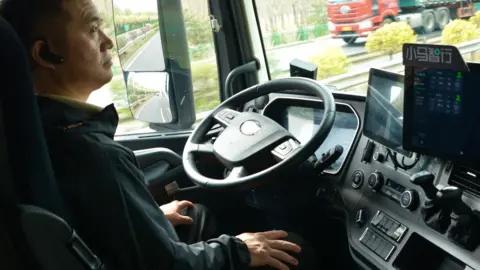**Title: On Board the Driverless Lorries Hoping to Transform China’s Transport Industry**
In recent years, the emergence of autonomous driving technology has caught the attention of numerous industries, particularly logistics and transportation. In China, we can observe this competitive spirit manifest in the form of driverless lorries traversing the highways connecting key cities such as Beijing and the Tianjin port. These large trucks, laden with cargo, demonstrate an ability to navigate complex routes with minimal human intervention, but the presence of a human “safety driver” adheres to existing government regulations. As the technology for autonomy in transportation advances, many experts and industry professionals believe that it won’t be long before operators are no longer required.
The experience of Huo Kangtian, a 32-year-old safety driver, serves as a revealing case study. When he first relinquished control to the autonomous system, he found the experience both exhilarating and unsettling. The transition from manual driving to an autonomous mode is a critical moment; Huo pressed buttons to activate the self-driving capabilities. The lorry seamlessly sped along the roadway, reminiscent of a standard driving experience, albeit with high-stakes tension inherent in relinquishing control to a machine. Huo’s perspective is worth noting: despite initial trepidation, his extensive testing has fostered confidence in the system, marking a departure from fear to trust.
As the driverless lorry approached toll gates, Huo reassumed control—his role as a safety driver is paramount, remaining as a contingency for emergencies where swift manual intervention may be required. Interestingly, he notes the advantages of automated driving: reduced stress and fatigue, as well as the potential for multi-tasking while the truck operates independently. Nevertheless, Huo expresses uncertainty regarding the long-term implications of this technology for his job, reflecting a broader sentiment among drivers in the industry.
Pony AI, the company behind this fleet of self-driving trucks, emphasizes the transformative potential of their technology beyond just the operational aspects. Vice President Li Hengyu claims that the future promises significant gains in transportation efficiency, particularly in terms of labor cost reduction and improved handling of challenging driving conditions. Yang Ruigang, an industry expert from Shanghai Jiaotong University, agrees, stating that investments in fully autonomous lorries will ultimately save companies money as they endeavor to reduce driver costs to nearly nothing.
Nevertheless, implementing autonomous trucks has not been without challenges. The tragic accident involving self-driving technology that resulted in fatalities has bred public skepticism regarding safety protocols. The Economist Intelligence Unit’s Chim Lee underscores that the public perception will ultimately shape policy and market acceptance, particularly in light of recent controversies surrounding autonomous passenger vehicles in China. Lee’s belief is that driverless lorries will be scrutinized heavily, making public trust essential for widespread adoption.
The landscape of autonomous delivery is evolving rapidly, especially in places like Hefei, a city in China’s Anhui Province, where hundreds of autonomous delivery vans are already operational. This city, once among the nation’s less prosperous, now showcases a pioneering spirit in adopting new technologies. Moreover, companies like Rino are identifying niche markets for driverless vans to facilitate deliveries from major distribution hubs to local neighborhoods, thereby enhancing efficiency through a hybrid logistics model.
Looking ahead, Zhang Qichen, Rino’s regional director for Anhui, states that the trend towards automated delivery vehicles will rapidly accelerate. She predicts a future where long-haul lorries may soon operate autonomously under controlled conditions. However, experts caution that common hurdles remain, including technical limitations like the need for improved sensory equipment to detect hazards and challenges presented by complex environments.
As China aims to champion new technology, there remains a delicate balance between fostering innovation while carefully monitoring public sentiment. The success of autonomous lorries will hinge on their ability to demonstrate reliability, thus easing fears surrounding potential accidents and job displacement. The future of transportation in China is interwoven with the performance of its autonomous technologies, and navigating these changes will require sensitivity to both technological advancement and societal implications.



